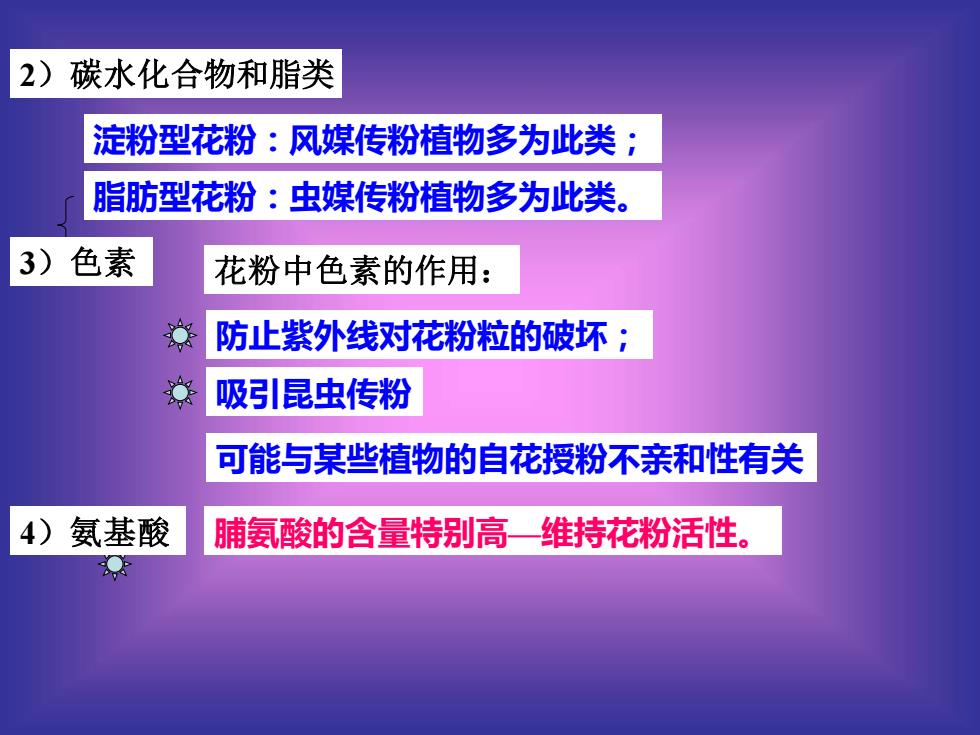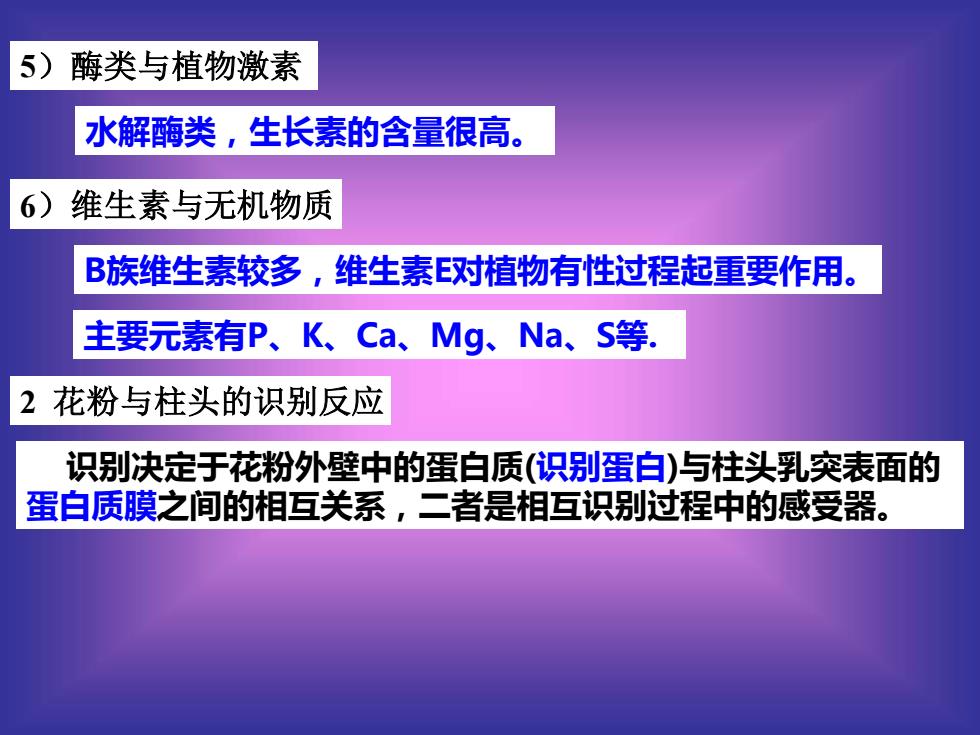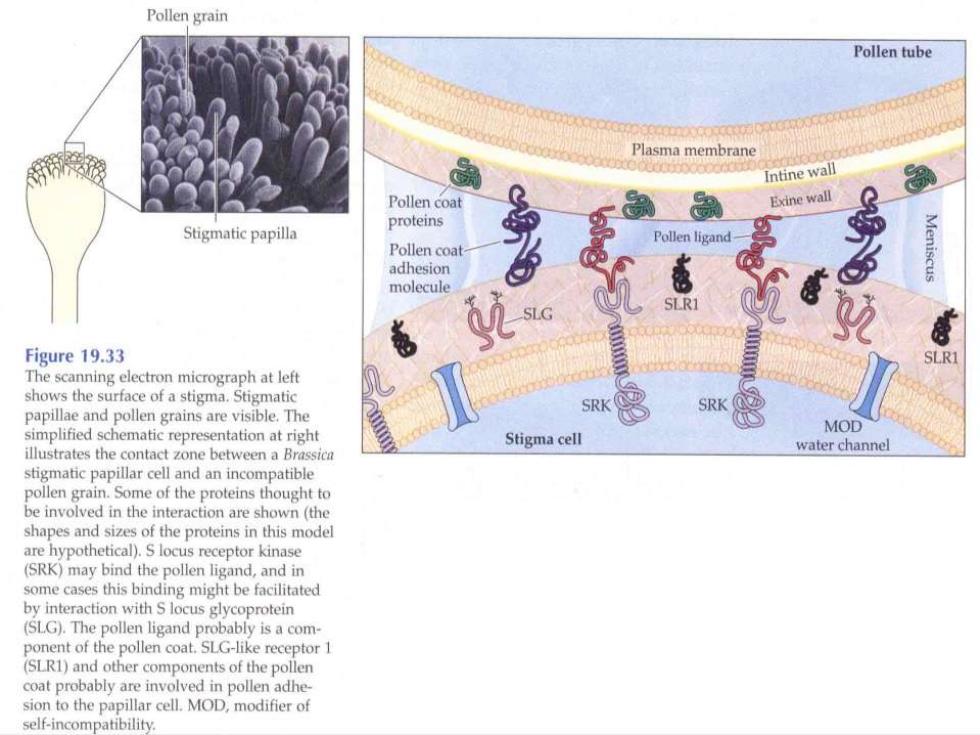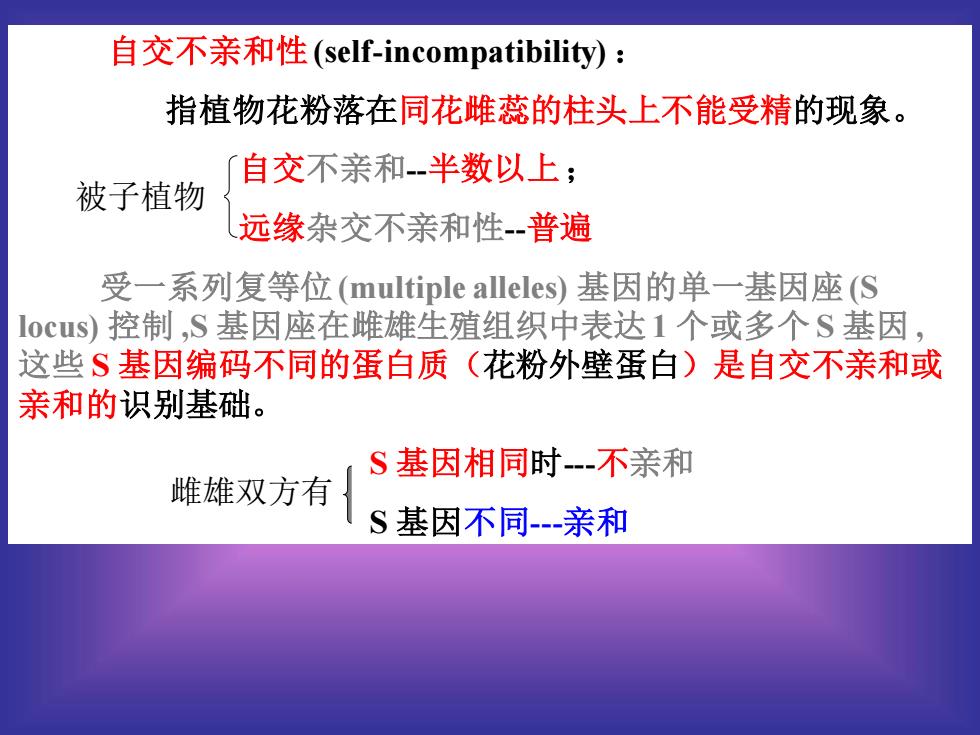
2)碳水化合物和脂类 淀粉型花粉:风媒传粉植物多为此类; 脂肪型花粉:虫媒传粉植物多为此类。 3)色素 花粉中色素的作用: 防止紫外线对花粉粒的破坏; 吸引昆虫传粉 可能与某些植物的自花授粉不亲和性有关 4)氨基酸 脯氨酸的含量特别高—维持花粉活性
2)碳水化合物和脂类 淀粉型花粉:风媒传粉植物多为此类; 脂肪型花粉:虫媒传粉植物多为此类。 3)色素 花粉中色素的作用: 防止紫外线对花粉粒的破坏; 吸引昆虫传粉 可能与某些植物的自花授粉不亲和性有关 4)氨基酸 脯氨酸的含量特别高—维持花粉活性

5)酶类与植物激素 水解酶类,生长素的含量很高。 6)维生素与无机物质 B族维生素较多,维生素E对植物有性过程起重要作用。 主要元素有P、K、Ca、Mg、Na、S等. 2 花粉与柱头的识别反应 识别决定于花粉外壁中的蛋白质(识别蛋白)与柱头乳突表面的 蛋白质膜之间的相互关系,二者是相互识别过程中的感受器
5)酶类与植物激素 水解酶类,生长素的含量很高。 6)维生素与无机物质 B族维生素较多,维生素E对植物有性过程起重要作用。 主要元素有P、K、Ca、Mg、Na、S等. 2 花粉与柱头的识别反应 识别决定于花粉外壁中的蛋白质(识别蛋白)与柱头乳突表面的 蛋白质膜之间的相互关系,二者是相互识别过程中的感受器

Pollen grain Pollen tube Plasma membrane Intine wall Pollen coat Exine wall Stigmatic papilla proteins Pollen ligand Pollen coat adhesion Meniscus molecule Figure 19.33 SLRI The scanning electron micrograph at left shows the surface of a stigma.Stigmatic papillae and pollen grains are visible.The SRK SRK simplified schematic representation at right MOD Stigma cell illustrates the contact zone between a Brassica water channel stigmatic papillar cell and an incompatible pollen grain.Some of the proteins thought to be involved in the interaction are shown(the shapes and sizes of the proteins in this model are hypothetical).S locus receptor kinase (SRK)may bind the pollen ligand,and in some cases this binding might be facilitated by interaction with S locus glycoprotein (SLG).The pollen ligand probably is a com ponent of the pollen coat.SLG-like receptor 1 (SLR1)and other components of the pollen coat probably are involved in pollen adhe- sion to the papillar cell.MOD,modifier of self-incompatibility

自交不亲和性(self-incompatibility) : 指植物花粉落在同花雌蕊的柱头上不能受精的现象。 自交不亲和-半数以上; 远缘杂交不亲和性-普遍 受一系列复等位(multiple alleles) 基因的单一基因座(S locus) 控制 ,S 基因座在雌雄生殖组织中表达 1 个或多个 S 基因 , 这些 S 基因编码不同的蛋白质(花粉外壁蛋白)是自交不亲和或 亲和的识别基础。 S 基因相同时-不亲和 S 基因不同-亲和 雌雄双方有 被子植物
自交不亲和性(self-incompatibility) : 指植物花粉落在同花雌蕊的柱头上不能受精的现象。 自交不亲和-半数以上; 远缘杂交不亲和性-普遍 受一系列复等位(multiple alleles) 基因的单一基因座(S locus) 控制 ,S 基因座在雌雄生殖组织中表达 1 个或多个 S 基因 , 这些 S 基因编码不同的蛋白质(花粉外壁蛋白)是自交不亲和或 亲和的识别基础。 S 基因相同时-不亲和 S 基因不同-亲和 雌雄双方有 被子植物

自交不亲和性可分 孢子体型不亲和性 (sporophytic self -incompatibility,SSI) -SSI植物(少),如十字花科、菊科等, 表现在花粉和雌蕊相互作用 , 阻碍花粉水合作用或 不能形成花粉管。发生在柱头表面,表现为花粉管 不能穿过柱头。 配子体型不亲和性 (gametophytic self -incompatibility,GSI) -GSI植物(多),如茄科、禾本科等, 不亲和发生在花粉管进入花柱后 , 中途生长停顿、破裂
自交不亲和性可分 孢子体型不亲和性 (sporophytic self -incompatibility,SSI) -SSI植物(少),如十字花科、菊科等, 表现在花粉和雌蕊相互作用 , 阻碍花粉水合作用或 不能形成花粉管。发生在柱头表面,表现为花粉管 不能穿过柱头。 配子体型不亲和性 (gametophytic self -incompatibility,GSI) -GSI植物(多),如茄科、禾本科等, 不亲和发生在花粉管进入花柱后 , 中途生长停顿、破裂